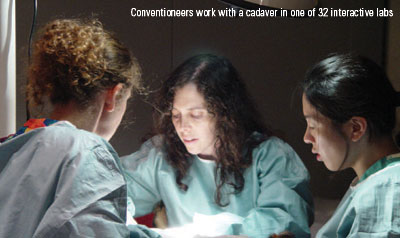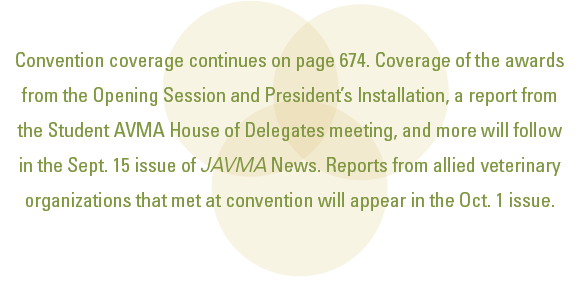AVMA Annual Convention spotlights one-health concept

From Opening Session to a series of special meetings, the one-health concept was an overarching theme throughout the 144th AVMA Annual Convention, held July 14-18 in Washington, D.C.
The event attracted 10,339 attendees, breaking the previous record of 10,191 that was set at the 2006 convention in Honolulu. Included in the total were 4,215 veterinarians, 400 veterinary students, and 462 veterinary technicians and technician students.
The one-health concept was echoed during the Opening Session (see page) when Julie L. Gerberding, MD, director of the Centers for Disease Control and Prevention and administrator of the Agency for Toxic Substances and Disease Registry, gave her keynote presentation. Dr. Gerberding said that veterinarians and physicians must present a seamless front to protect human and animal health in a small world.
Two special sessions on the one-health concept were held July 16 (see page). One session focused on emerging global animal health threats and included a presentation by U.S. Ambassador John E. Lange, who is the nation's representative on avian and pandemic influenza and heads the State Department's Avian Influenza Action Group.
During the other session, organized veterinary and human medical professionals discussed the need for the two groups to work together to more effectively prevent, diagnose, and treat diseases affecting people and animals.
Key presenters were Dr. Roger K. Mahr, 2006-2007 AVMA president, who made the one-health initiative his top priority during his presidency, and Ronald M. Davis, MD, president of the American Medical Association. The AMA recently adopted a policy supporting the AVMA's one-health initiative. Also presenting was Jarbas Barbosa, MD, head of infectious diseases at the Pan American Health Organization.

"I was extremely pleased that this year's convention provided a venue at our nation's capital for the culmination of a multitude of actions and presentations which not only supported the one-health concept, but created further momentum for the one-health initiative," Dr. Mahr said.
"Many of our international guests communicated their support for the one-health initiative and expressed their desire to engage their associations and countries in the initiative," he added.
Another highlight at the Opening Session, sponsored by Hill's Pet Nutrition, came when Major Scott Willens, a veterinarian serving with the U.S. Army, sang "God Bless the USA" live from Iraq via satellite link, and his family was in the audience. Also, a tribute was paid to Dr. Bruce W. Little, AVMA executive vice president, who retired from his post Aug. 8.

A well-attended event was the AVMA-arranged expert panel that reviewed the massive recalls of pet food (see page). Dr. Stephen F. Sundlof, director of the Food and Drug Administration's Center for Veterinary Medicine, was included on the panel.
Sponsored by Pfizer Animal Health, the third annual Veterinary Diversity Symposium featured sessions on understanding cultural competence and how it can help veterinarians better serve African-American, Asian-American, and Hispanic clientele; dispelling disability myths; and how to make practices more attractive to the gay, lesbian, bisexual, and transgender community.

Overall, attendees chose from more than 1,000 continuing education sessions with 600-plus speakers. Topics covered included advances in veterinary medicine, species-specific medicine; complementary/alternative medicine, personal/professional development, food safety, and public health practice. Thirty-two interactive laboratories were available.
More than 300 exhibitors were featured in the exhibit hall. The AVMA Veterinary Medical Assistance Teams and the U.S. Army Veterinary Corps each had large tents on display. The VMAT tent included a set-up for responding to animals during a disaster, while the Army display offered visitors a chance to visit with Army veterinarians about joining.
The convention offered a wide-ranging mix of entertainment, including the first AVMA/Merial Concert Series, featuring the Goo Goo Dolls, and AVMA Family Night, sponsored by Bayer Animal Health, at the Smithsonian National Zoological Park. Also, on July 17, attendees got their kicks during the Final Fling, sponsored by Fort Dodge Animal Health and starring comedian Frank Caliendo.
The AVMA Welcome Center, sponsored by Novartis Animal Health, was staffed by volunteers from the District of Columbia VMA and the U.S. Army to supply information on Washington, D.C.
Convention news was dispersed to area hotels through the AVMA Convention News Network, sponsored by Fort Dodge Animal Health and co-sponsored by Subaru of North America. The 30-minute TV shows included segments on military veterinarians, the National Zoo, D.C. neighborhoods, and plenty more.
Dr. Gregory S. Hammer assumed the AVMA presidency, succeeding Dr. Roger K. Mahr. The AVMA House of Delegates elected Dr. James O. Cook as president-elect and re-elected Dr. Charles M. Hendrix as vice president. Drs. Larry R. Corry and Gary S. Brown declared their candidacies for 2008-2009 AVMA president-elect and vice president, respectively. Meanwhile, Dr. Corry was elected the new Executive Board chair.

During its session, the AVMA House of Delegates took no position on foie gras production, by disapproving resolutions condemning or supporting the controversial practice. The HOD did approve a resolution stating the AVMA's opposition to using information from companion animal microchip databases for purposes of marketing or referral. Turn to page 669 for full coverage of the HOD.
Dr. Dennis M. McCurnin, chair of the AVMA Convention Management and Program Committee, said the CMPC section managers and AVMA staff worked hard to put together a program that would be as good as, or better than, the 2006 program.
"They were successful in that we drew more attendees in Washington, D.C., than we did in Honolulu," Dr. McCurnin said. "This is a very difficult meeting to keep building on and improving each year, but the committee has done an outstanding job. All in all, we were very pleased with the convention and the responses we received from attendees."
